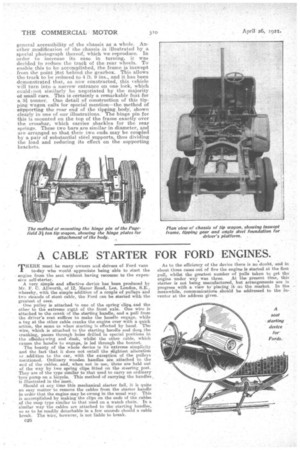A TIPPING WAGON FOR NARROW WAYS.
Page 21

Page 22

If you've noticed an error in this article please click here to report it so we can fix it.
A Successful Chassis, Designed Primarily for Liverpool's Narrow Places, yet Capable of Handling 3i Ton Loads.
IN THE issue of The Commercial Mellor for April oth we described the new Pagefield colonial model. Whilst we were at the works of Walker Bros. (Wigan), Ltd., the makers of the Pagefield, we were interested to note the progress which has taken place in connection with this company's K type chassis, which was originally designed to meet tho requirements of the Liverpool Corporation for a tipping wagon capable of manceuvring in confined spaces. This chassis has now become so well known, particularly in the colliery and factory districts of the north, that a considerable proportion of the works capabilities has had to be concentrated on to this type. .It
was shown, as most readers will recollect, at Olympia last October, but as it has undergone one or two alterations and improvements since then, it will not be out of place to make some further reference to it here. The driver's cab and floorboards are now mounted on a light steel framework, which can be removed en bloc after the freeing of comparatively few bolts. It should be pointed out that its removal is not necessary in order to obtain access to the engine, which may be got at with ease by the lifting of the bonnet cover and the removal of a couple of floorboards, but has been. designed with a yiew to increasing the
general accessibility of the chassis as a. whole. Another modification of the chassis is illustrated by a special photograph thereof, which we reproduce. In order to increase its ease in turning, it was decided.to reduce the track of the rear wheels. To enable this to be accomplished, the frame is inswept from the point jest behind the gearbox. This allows the track to be reduced to 4 ft. 9 ins., and it has been demonstrated that, as now constructed, this vehicle will turn into .a narrow entrance on one lock, which could-i not similarly be negotiated by the majority a small cars. This is certainly a remarkable feat for a 3i tonner. One detail of construction of this tipping wagon calls for special mention—the method of sftpporting the rear end of the tipping body, shown clearly in one of our illustrations. The hinge pin for this is mounted on the top of the frame exactly over the crossbar, which carries shackles for the rear springs. These two bars are similar in diameter, and are arranged so that their two ends may be coupled by a pair of substantial steel supports, thus dividing the load and reducing its effect on the supporting brackets.
































